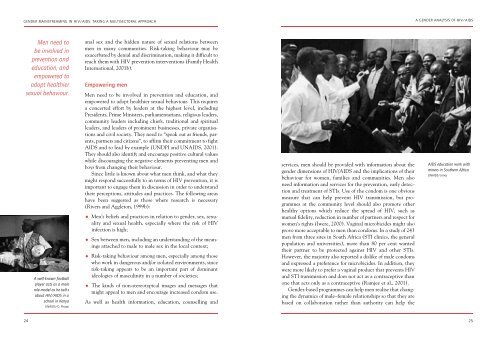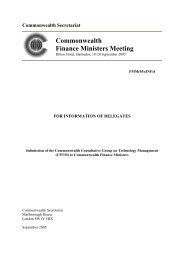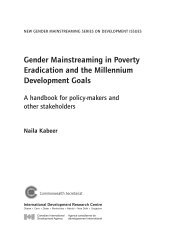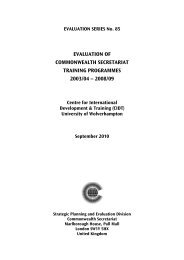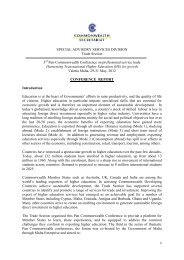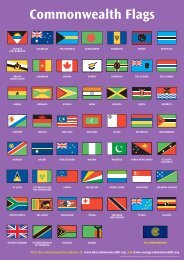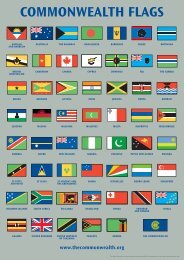Gender Mainstreaming in HIV/AIDS - Commonwealth Secretariat
Gender Mainstreaming in HIV/AIDS - Commonwealth Secretariat
Gender Mainstreaming in HIV/AIDS - Commonwealth Secretariat
You also want an ePaper? Increase the reach of your titles
YUMPU automatically turns print PDFs into web optimized ePapers that Google loves.
GENDER MAINST R E A M I NG IN <strong>HIV</strong>/<strong>AIDS</strong>: TA K I NG A MULT I S E C TORAL APPROACH<br />
Men need to<br />
be <strong>in</strong>volved <strong>in</strong><br />
prevention and<br />
education, and<br />
empowered to<br />
adopt healthier<br />
sexual behaviour.<br />
A well-known football<br />
player acts as a male<br />
role-model as he talks<br />
about <strong>HIV</strong>/<strong>AIDS</strong> <strong>in</strong> a<br />
school <strong>in</strong> Kenya<br />
UN<strong>AIDS</strong>/G. Pirozzi<br />
anal sex and the hidden nature of sexual relations between<br />
men <strong>in</strong> many communities. Risk-tak<strong>in</strong>g behaviour may be<br />
exacerbated by denial and discrim<strong>in</strong>ation, mak<strong>in</strong>g it difficult to<br />
reach them with <strong>HIV</strong> prevention <strong>in</strong>terventions (Family Health<br />
International, 2001b).<br />
Men need to be <strong>in</strong>volved <strong>in</strong> prevention and education, and<br />
empowered to adopt healthier sexual behaviour. This requires<br />
a concerted effort by leaders at the highest level, <strong>in</strong>clud<strong>in</strong>g<br />
P residents, Prime M<strong>in</strong>isters, parliamentarians, religious leaders,<br />
community leaders <strong>in</strong>clud<strong>in</strong>g chiefs, traditional and spiritual<br />
leaders, and leaders of prom<strong>in</strong>ent bus<strong>in</strong>esses, private organisations<br />
and civil society. They need to “speak out as friends, parents,<br />
partners and citizens”, to aff i rm their commitment to fight<br />
<strong>AIDS</strong> and to lead by example (UNDPI and UN<strong>AIDS</strong>, 2001).<br />
They should also identify and encourage positive cultural values<br />
while discourag<strong>in</strong>g the negative elements prevent<strong>in</strong>g men and<br />
boys from chang<strong>in</strong>g their behaviour.<br />
S<strong>in</strong>ce little is known about what men th<strong>in</strong>k, and what they<br />
might respond successfully to <strong>in</strong> terms of <strong>HIV</strong> prevention, it is<br />
important to engage them <strong>in</strong> discussion <strong>in</strong> order to understand<br />
their perceptions, attitudes and practices. The follow<strong>in</strong>g areas<br />
have been suggested as those where research is necessary<br />
(Rivers and Aggleton, 1999b):<br />
• Men’s beliefs and practices <strong>in</strong> relation to gender, sex, sexuality<br />
and sexual health, especially where the risk of <strong>HIV</strong><br />
<strong>in</strong>fection is high;<br />
• Sex between men, <strong>in</strong>clud<strong>in</strong>g an understand<strong>in</strong>g of the mean<strong>in</strong>gs<br />
attached to male to male sex <strong>in</strong> the local context;<br />
• Risk-tak<strong>in</strong>g behaviour among men, especially among those<br />
who work <strong>in</strong> dangerous and/or isolated environments, s<strong>in</strong>ce<br />
risk-tak<strong>in</strong>g appears to be an important part of dom<strong>in</strong>ant<br />
ideologies of mascul<strong>in</strong>ity <strong>in</strong> a number of societies;<br />
• The k<strong>in</strong>ds of non-stereotypical images and messages that<br />
might appeal to men and encourage <strong>in</strong>creased condom use.<br />
As well as health <strong>in</strong>formation, education, counsell<strong>in</strong>g and<br />
services, men should be provided with <strong>in</strong>formation about the<br />
gender dimensions of <strong>HIV</strong>/<strong>AIDS</strong> and the implications of their<br />
behaviour for women, families and communities. Men also<br />
need <strong>in</strong>formation and services for the prevention, early detection<br />
and treatment of STIs. Use of the condom is one obvious<br />
measure that can help prevent <strong>HIV</strong> transmission, but programmes<br />
at the community level should also promote other<br />
healthy options which reduce the spread of <strong>HIV</strong>, such as<br />
mutual fidelity, reduction <strong>in</strong> number of partners and respect for<br />
women’s rights (Iwere, 2000). Vag<strong>in</strong>al microbicides might also<br />
prove more acceptable to men than condoms. In a study of 243<br />
men from three sites <strong>in</strong> South Africa (STI cl<strong>in</strong>ics, the general<br />
population and universities), more than 80 per cent wanted<br />
their partner to be protected aga<strong>in</strong>st <strong>HIV</strong> and other STIs.<br />
However, the majority also reported a dislike of male condoms<br />
and expressed a preference for microbicides. In addition, they<br />
were more likely to prefer a vag<strong>in</strong>al product that prevents <strong>HIV</strong><br />
and STI transmission and does not act as a contraceptive than<br />
one that acts only as a contraceptive (Ramjee et al., 2001).<br />
<strong>Gender</strong>-based programmes can help men realise that chang<strong>in</strong>g<br />
the dynamics of male–female relationships so that they are<br />
based on collaboration rather than authority can help the<br />
A GENDER ANA LYSIS OF <strong>HIV</strong>/<strong>AIDS</strong><br />
<strong>AIDS</strong> education work with<br />
m<strong>in</strong>ers <strong>in</strong> Southern Africa.<br />
24 25<br />
UN<strong>AIDS</strong>/Jones


